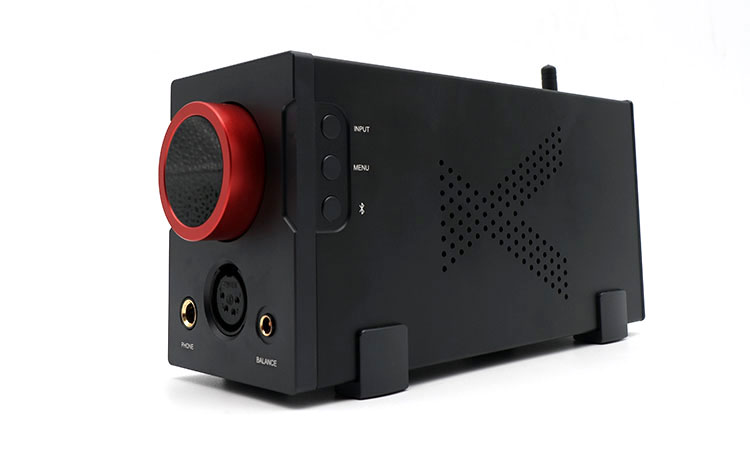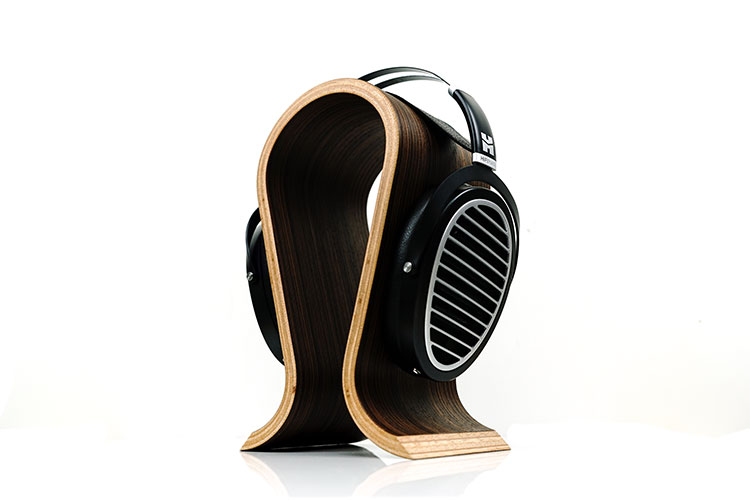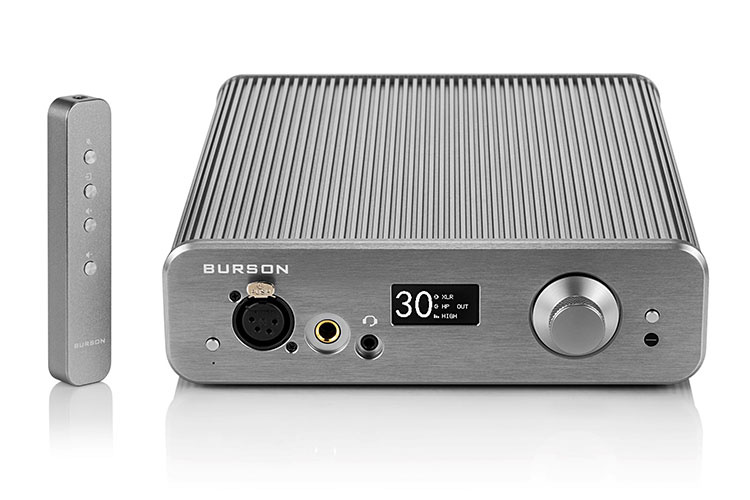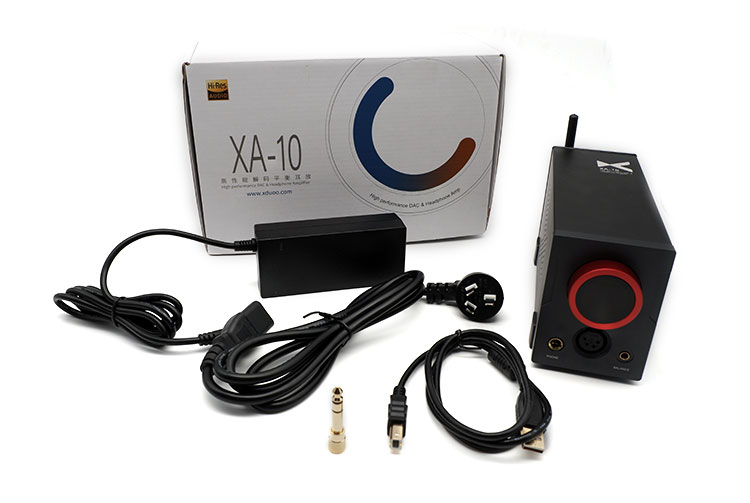Synergy
With 4W of power, the XA-10 can easily drive all the headphones that I have on my desk. From the high-impedance Audio Technica ATH-ADX5000 to highly efficient IEMs thanks to the integrated digital volume control. The XA-10 can also push out a respectable amount of current to power my planar magnetic headphones like the Hifiman Ananda or the Goldplanar GL2000.
Audio Technica ATH-ADX5000
While the ADX5000 needs to be pushed a bit harder than most headphones, the XA-10 managed it superbly. With the amount of control that the XA-10 exerts on the XA-10, the bass is controlled very well and the sense of attack and impact is very immediate.
Midrange textures can easily be picked out while keeping a good amount of warmth in the midrange instrumental timbre. Treble is slightly forward on the ADX5000, and this is nicely complemented by the slightly more conservative approach to the treble of the XA-10.
While the soundstage is not particularly enhanced by the XA-10, the width remains respectable. Image directionality retains its accuracy, but the images created could be slightly more chiseled.
Hifiman Ananda
Complementing pairings is crucial when mixing and matching headphones to amplifiers. And this is what I found to be the case between the XA-10 and the Hifiman Ananda. With the Ananda having a relatively wide soundstage with a pleasing tonality with a slight treble uptick.
The XA-10 nicely complements Ananda’s sound signature, with the XA-10 suppling a slightly more engaging sense of attack to enhance the polite bass region of the Ananda. The treble on the Ananda is already relatively forward, but with the XA-10 as the source, Ananda’s treble resolution shines through while still remaining safe.
The soundstage on the Ananda naturally sounds wide, and the XA-10 doesn’t detract from that too much. With the Ananda, I believe the pairing is quite good since the 2 devices easily make up for each other’s slight shortcomings.
Select Comparisons
SMSL SU-9/SH-9 stack
Technical
The SMSL stack is slightly more expensive than the XA-10, but it’s still an interesting comparison since they have pretty much the same features when the entire stack is compared to the XA-10.
The input and output options are quite similar with both having options for Bluetooth, optical, coaxial, and USB. Analog inputs are a bit different though, since the SH-9 has options for both balanced and single-ended inputs, while the XA-10 is limited to single-ended inputs only.
Both amplifiers are equipped with Bluetooth, but the XA-10 is limited to just LDAC, while the SU-9 has UAT protocol compatibility. UAT protocol compatibility enables the SU-9 to have a maximum resolution of 24/192Khz through Bluetooth, in contrast to just 32/96Khz through LDAC.
SMSL went with the ESS 9038 Pro DAC chip, while XA-10 is equipped with 2xAKM4493 DAC chips. Both configurations are capable of decoding into at least 4 channels for a fully balanced output, so they are equally capable of balanced outputs as DACs. Both DACs are also capable of fully decoding MQA.
In terms of outputs, the SU-9 has an option to control the volume of the pre-outs that are available in both balanced and single-ended, while the XA-10 is limited to a pair of full-scale single-ended outputs.
The SH-9 offers headphone outputs in the form of a single-ended ¼” output and a 4-pin xlr output, while the XA-10 offers an additional 4.4mm pentaconn connection in addition to the 2 more traditional headphone connections.
Headphone amplifier power output is quite similar on the 2 amplifiers, where the SH-9 offers 3W into 32Ω through both the balanced and single-ended output, while the XA-10 outputs 3W into 32Ω single-ended, and 4W into 32Ω through the balanced outputs.
Design
While the 2 systems seem like different implementations that have a similar end result, the XA-10 has a significantly more compact footprint. With a slimmer but slightly taller profile. Both the SU-9 and the SH-9 are equipped with a colored screen, with a volume dial that can be clicked for the menu options, while the XA-10 only has an orange LED display.
Aside from the colored display, the SU-9/SH-9 are equipped with a remote control that can operate both devices. The XA-10 on the other hand is designed to just sit on the desk as a headphone amplifier and controls can only be done manually on the unit itself.
Performance
On paper, the specs say that the SMSL SU-9/ SH-9 should be quite similar to the XA-10. However, my listening sessions yielded significantly different results.
Comparing the XA-10 to the SU-9/SH-9 stack, the XA-10 has a significantly more prominent sense of attack, while having a slightly warmer midrange tonality. The treble is slightly more extended on the SU-9/SH-9 stack though.
The soundstage is slightly wider on the SU-9/SH-9 stack because of a slightly airier presentation. Both devices are equally capable of creating an accurate image with the XA-10 having a slightly more layered presentation, but the SU-9/SH-9 stack is slightly more chiseled because of a slightly lighter presentation.
Feeding the XA-10’s aux input with the SU-9 DAC, the XA-10’s amp can be directly compared to the SH-9. With this setup, it’s noticeable that the XA-10 has a more impactful and energetic presentation overall, while the SH-9 is generally colder.
The XA-10’s treble is more extended in this mode of operation, and this makes the soundstage just as wide as the SH-9, but the XA-10 has a more layered presentation.
While the price gap between the SU-9/SH-9 stack and the XA-10 is quite significant, it’s interesting to see how the 2 manufacturers prioritized different things. Where SMSL created a more layered and dynamic DAC in the SU-9, xDuoo put in a class-A headphone amplifier in the XA-10 giving it a more layered and impactful presentation than the SH-9.
Khadas Tone2 Pro
Technical
The Khadas Tone2 Pro and the XA-10 both use the same XMOS XU216 USB controller, and this gives the 2 devices a similar ability to do full MQA decoding.
The internal DAC chips are a bit different though since the Khadas Tone2 Pro has an ESS 9038Q2M, which only has 2 audio channels, while the XA-10 is equipped with a pair of AKM 4493 chips that sport 4 channels of audio decoding.
Headphone amplifier outputs are significantly different between the 2 devices. The headphone output section of the Tone2 Pro is based on 4xOPA1612 headphone amplifiers, while the XA-10 is equipped with a discrete class-A headphone amplifier section.
There is also a significant difference in rated power outputs, where the Tone2 Pro can pump out a minuscule 211mW into 32Ω, while the XA-10 pumps out a maximum of 4W into 32Ω. Despite the power difference, the Tone2 Pro can surprisingly push some moderately hard-to-drive headphones.
Design
The Khadas Tone2 Pro is a significantly smaller device, and it doesn’t require an external power supply to run. The form factor of the 2 devices is also significantly different, where the Khadas Tone2 Pro is a tiny DAC/Amp combo that’s about the size of a credit card, while the XA-10 is more of a small desktop headphone amplifier.
The XA-10 has significantly more input options with the addition of Bluetooth and optical input. The XA-10 also features output options that are geared towards desktop applications such as a ¼” output, 4.4mm pentaconn balanced output, and a 4-pin xlr output, instead of the 3.5mm single-ended output and 4.4mm pentaconn balanced output available on the Tone2 Pro.
Khadas Tone2 Pro also features a pair of backward-compatible balanced RCA outputs at the back, while the XA-10 is only limited to a pair of single-ended RCA outputs if the XA-10 is used as a pure DAC.
Performance
With a significant gap in the power output for the headphone amplifier section, comparing the XA-10 and the Tone2 Pro as a DAC/Amp is straight up unfair. While both DAC/amps have a generally neutral sound signature, the significant power disparity between the 2 devices plays a huge role.
The XA-10 has a more spaced-out presentation and has a better sense of attack with drum hits. Interestingly, there is a better sense of control in the bassline with the Tone2 Pro. It’s also important to note that the Tone2 Pro can’t really power hard-to-drive headphones, and it can barely power my ADX5000 to respectable volume levels.
What’s more interesting though, is comparing the DAC sections of both amplifiers. So I tried using the Tone2 Pro as an upstream DAC to the XA-10. With this combination, it’s immediately apparent that there is an improvement when it comes to the control of the bass region. The bass is much more rounded than when the XA-10’s DAC is used.
The midrange and treble also became noticeably more nimble. While vocal textures are about equally apparent, the treble is slightly more crystalline with the Tone2 Pro’s DAC section. While the Tone2 Pro DAC significantly improves clarity, it is a smidge less impactful and thinner than the onboard DAC.
Burson Soloist 3X
The Burson Soloist 3X is just an amplifier with an output power of 4W into 32Ω, that accepts both single-ended and balanced outputs, and it currently sells for around $1195. While the power specs of the 2 amplifiers are similar, the price disparity should mean a lot right? Well, it’s not that simple.
Technical
With both amplifiers running a class-A topology, they are more similar than the price disparity might initially suggest. The volume control of the 2 amplifiers also employs similar IC-based volume control, so they both have good channel matching down to the lowest volume levels.
The Soloist 3X features a few extras that justify its higher price tag though, and these include Burson’s proprietary Max Current Power Supply(MCPS) technology. This promises to give the amplifier a better dynamic range and slew rate control. The Soloist 3X also features interchangeable op-amps and comes with Burson’s V6 Vivid opamps out of the box.
Aside from these features, the Soloist 3X also has a pair of 3pin balanced inputs, and it can work as a pre-amp to a downstream device. Finally, the Soloist 3X also comes with a remote control so it doesn’t have to be confined to small desktop headphone setups.
Design
The Soloist 3X is a larger device, with a flatter profile than the XA-10. They both have a similar-looking display, where there is an LED display in front that shows the information on volume level, input modes, and gain level.
The Soloist and the XA-10 both run pretty hot, but the Soloist has an aluminum chassis that’s shaped like a heat sink, so heat dissipation is significantly more efficient with the Soloist. Both amplifiers are warm to the touch when they are running.
Performance
For my listening tests, I ran both amplifiers using my Chord 2qute DAC. When I started testing them using my ADX5000, it’s curious that the volume level for comfortable listening levels with the XA-10 is at around 49 at high gain, while only needing around 10 at high gain on the Soloist 3X.
While I believe this is not a huge issue, but it seems that the Soloist 3X might be able to push a bit more power, even when it says that they have the same power numbers on paper.
With the 2 amplifiers both running in class A, they are actually more similar than they are different. They have a similar amount of warmth and thickness to the overall sound. They also have a similar level of layering and soundstage width, only that the Soloist has a tinge more precision than the XA-10.
Both amplifiers do well with dynamic range, but the Soloist has a touch more refinement in the more gentle passages of orchestral pieces. Vocal and midrange instrument texture is also a bit more chiseled with the Soloist 3X. The instrument timbre is actually quite similar, where the Soloist is just a touch brighter and more nimble than the XA-10.
While employing similar technologies, the 2 amplifiers are shockingly similar. The Soloist 3X is definitely a more refined experience when compared to the XA-10, but it’s really impressive how the XA-10’s class-A amplifier is keeping up with an amplifier that is more than 2x its SRP.
Our Verdict
The xDuoo XA-10 is an all-in-one unit that crammed everything into a small device. It has a very capable DAC with MQA full decoding capability, with a warm tonality and an energetic sense of attack. It’s also capable of Bluetooth input, with both aptX HD and LDAC connectivity options.
The headphone amp section on the XA-10 has impressively premium features though, and these include balanced class-A topology capable of 4W into 32Ω and IC-based precision volume control. These features give the XCA-10 exceptional dynamic range and imaging depth, which sets it apart from a market that is currently flush with opamp-based headphone amplifiers.
xDuoo XA-10 Specifications
- Output Power(Balanced) 4000mW @ 32Ω.
- Output Power(Single-ended) 3000mW @ 32Ω.
- Suitable Headphone Impedance 16Ω-600Ω.
- THD+N 0008%.
- SNR(Balanced)
- SNR(Single-Ended)
- Power Supply DC12V/3A.
- Weight 9Kg.
- Inputs Bluetooth, USB, optical, coaxial, RCA







